Volleyball drills
After every part a short rest and continue. For parts with *, a bench is required, 2 to 4 persons per bench
- Deel 1:
- 30 step-ups* (step up/down bench)
- 15 push-ups* (feet on bench)
- 30 step-ups*
- 15 spiderman push-ups (pull up 1 leg as a frog at the same time as push ups)
- Part 2:
- 30 east-west steps-ups* (right foot on bench, left foot besides, then left foot on right foot besides)
- 10 squats jumps (bend the knees and when stretching jump as high as possible)
- 30 east-west steps-ups*
- 10 squats jumps
- Part 3:
- 20 sideways shuffles over 4 meter
- 10 slit-squat jump (jump, and bend 1 knee, each time a different knee)
- Part 4:
- 20 forward and backward sprints over 4 meters
- 10 squats jumps
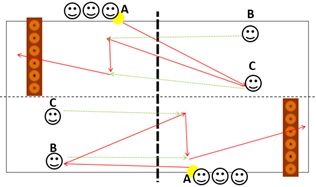
- Player A throws the ball over the net.
- Player B or C passes the ball over the net.
- The other player quickly runs underneath the net, and sets up for the same player that passed.
- This player tries to hit a cone from the bench with overarm player or a hitting movement.
Which pair or which team has hit the most cones from the bench after an X number of minutes?
A big mistake during blocking is that players mostly watch the ball. From the moment the ball leaves the playmaker until the moment of hitting the volleyball by the attacker, the ball is watched. However, the most information can be derived from the attacker. Where is the ball going to be hit, how are the shoulders? The task is to teach the players, after they have seen which attacker is served by the playmaker, to watch the attacker.
In this exercise the trainer is standing behind the pair that forms the blocking. The trainer throws the ball over the net and the attackers hit the ball. Blocking players can no longer follow ball and they have to watch the attacker. Of course, the trainer can apply further technical improvements, such as the position of the hand, what to do after the block landing, and the way of landing
if the trainer want to keep his or her hand free to apply technical improvements while the rest of the exercise continues, the attacker can throw the ball one by one, or the playmakers.
Variations are:
1: only an outside block
2: with mid block
3: also position attackers at the mid position
It is important the players focus on the attacker.
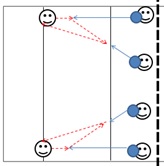
See picture. Each trio 2 balls. 2 players at the net number of meters from each other, other player in the back field.
- Exercise 1: Players rapidly throw in turns, player in the back field returns ball underhand.
- First ball is deep, 2nd ball is short
- Exercise 3: Throwers increase their distance apart and throw straight: player with ball at the side line throws deep, other short .
Change places after x number of balls or after a certain time.
Hit to outside and middle
Daarna
Beside the playmaker, the other players execute a pass, an attack, and a service.
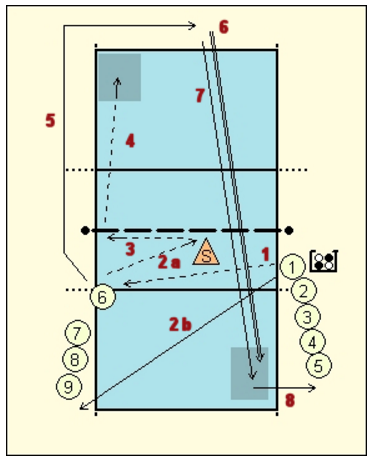
The exercise is as follows:
- 1 Player 1 throws a tight ball to player 7
- 2a player 7 passes the ball to the playmaker
- 2b player 1 walks to the other line and joins the back.
- 3 the playmaker gives a set up to player 6
- 4 player 6 smashes the ball to the mat
- 5 player 6 picks up his own ball
- 6 player 6 serves the ball to the other mat
- 7 player 6 picks up his own ball
- 8 player 6 joins the line
- This can also be done a middle attack
After 10 minutes, a block is added
- make 2 equal teams.
- Each team has 1 ball on their own field
- Trainer throws rally ball into field of a team
- Team plays 3 times before ball goes to the other team
- Player can have only 1 ball at the same time
- If the ball is dropped or similar, the other team scores a point.
- Stand up straight with your feet a bit wider than a shoulder's width apart.
- Grab your feet at the toes, while keeping your legs stretched.
- Move your hips downwards until between your ankles and move your breast forward.
- Move your hips back up again until your legs are stretched. Keep your back straight and keep holding your toes.
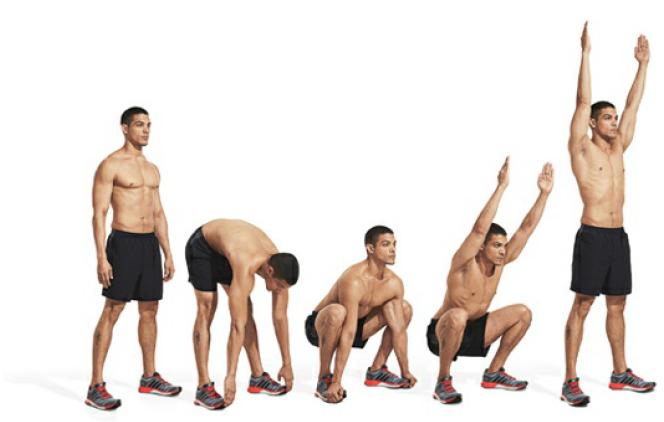
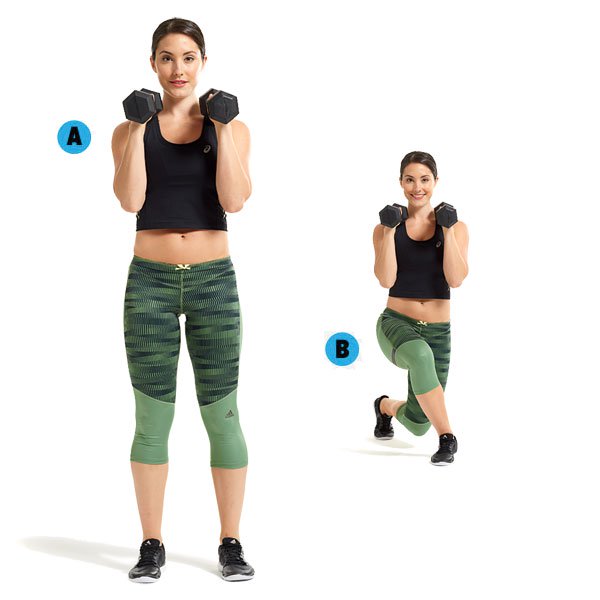 Start from an upright position
Start from an upright position
- Place your left foot diagonally behind your right foot, at a distance of about 60 cm.
- Rotate your hips back in the direction your right foot is pointing.
- Lower your right leg and keep the heel of your right foot on the ground
- Return to the starting position and repeat the movement with your other body half.
- Repeat these movements a number of times.
- Make a step backwards with your right foot from an upright position.
- Turn your torso towards your left knee, while you reach up as far as possible with your right hand.
- Turn back, get back up again, and repeat the same movement with the other side of your body.
- Repeat these movements a number of times.
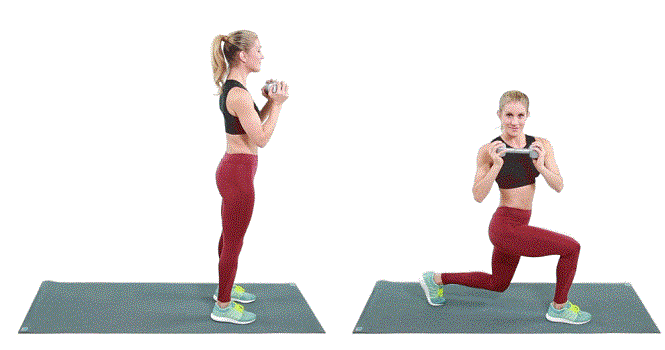
- Take a large step forward with your right foot from an upright position
- Put your left hand on the ground, at a shoulder's width distance beside your right foot, and divide your weight over your left hand and right foot.
- Bend your right arm, and bring your right elbow to the ground between your left hand and your right foot.
- Put your right hand next to your right foot. Do this on the outside, and not on the side here you previously had placed your elbow.
- Raise your hips, stretch both legs, and have your right foot point upwards.
- Return to the starting position and repeat the same movement with your left foot and right hand.
- Repeat these movements a number of times
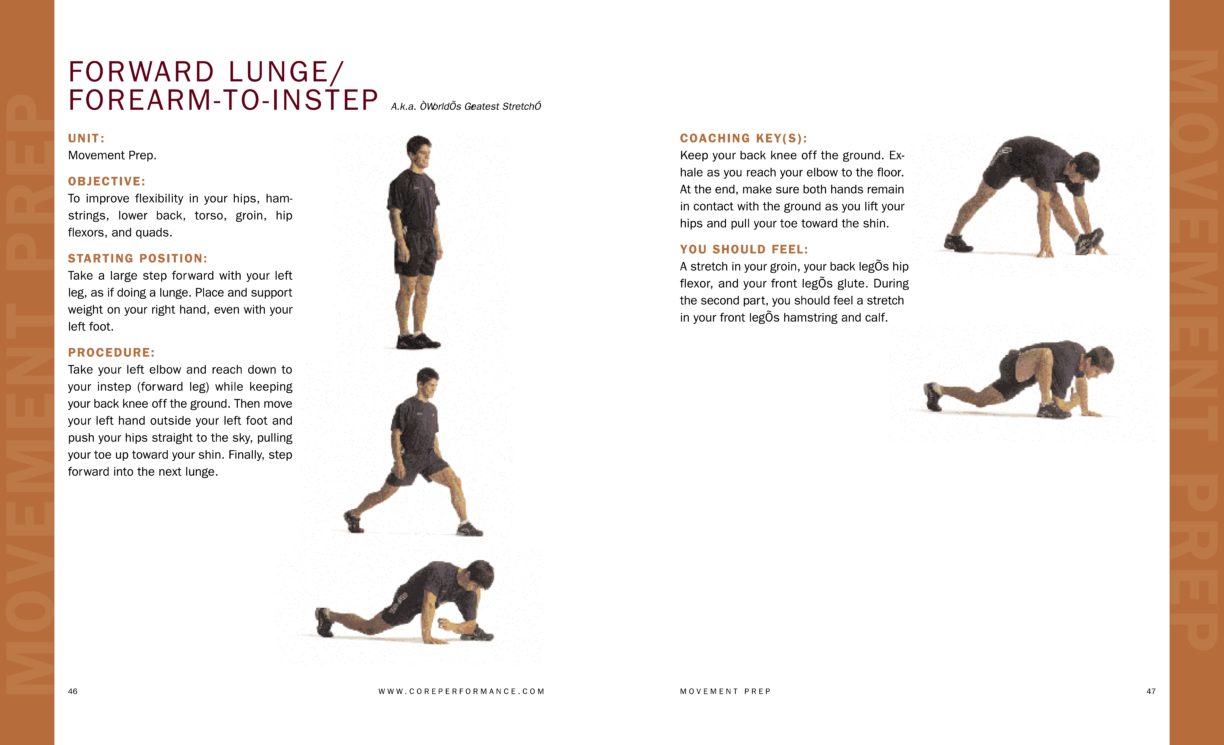
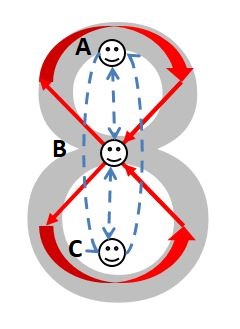
- Make trios
- Each trio has a ball.
- Player in the middle keeps running an 8. Every time this player comes in the middle, a ball is thrown:
- A throws (or plays overarm) the ball to B (in the middle)
- B throws the ball underhand back to A and then runs around A until he is back in the middle.
- Meanwhile, A plays the ball to C
- C returns the ball overarm to B.
- B plays the ball underhand back to C and then runs around C until he is back in the middle.
- Enz.
- after 2-3 minutes the player in the middle is changed.
Variation:
- To make it simpler, player A and C can throw instead of playing overarm. Could be underhand throwing/catching or overarm throwing/catching.
- To practice standing still when playing/throwing, player B can throw and catch underhand.
- The team is divided in 2 groups.
- Place a group on both sides of the net.
- 1 side will serve, the other side positions 3 passers
- They try to pass the ball high and this has to be caught on their own side.
- Servers take turns.
- A new passer will enter the field to replace the one who has caught the ball.
2 They play until 10 points. The servers score a point if the ball is not caught. The passers get a point if it is caught. Incorrect service does not count. After a round, they switch sides.deround with 2 passers instead of 3.








